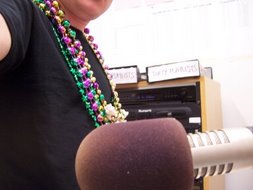
When the rain finally sputtered out on Sunday, we drove to Holt Cemetery, burial ground of paupers and the King of Jazz, Buddy Bolden (1877-1931). Tipped off to Bolden’s location by a documentary we’d watched on Saturday (part of an upcoming project, sketchy details to come…), we found the cemetery on Buddy Bolden Place, off of City Park Avenue, behind Delgado College. The gate stood open, the guard’s house was boarded up, the door to the fuse box hung open, streaked orange with rust. Another car sat in the rough driveway, apparently belonging to the slight, brown-haired kid who paced between tombstones, cellphone to his ear, keeping his distance from us.

The marker for Bolden stood out in its uprightness and clean face. Erected in 1998, the pale granite tombstone notes that Bolden is somewhere in the cemetery; he was buried in an unmarked grave after spending the last 24 years of his life in an asylum.

Holt is one of the only "underground" cemeteries in the city, i.e. inhabitants are buried in the earth, not housed in above ground tombs. When Katrina hit, this peculiarity meant severe devastation for the grave sites.
Across the yard, markers of all shapes and states of disrepair stood in front of plots covered in tarps, in gravel, in mud, in burnt charcoal, in junk. Flotsam left behind from the flood waters lay half-buried along half-buried flowers, tombstones broken in half, piles of bright junk arranged to suggest ceremony, meaning. A “Twister” pad lay in front of a squat, hand-painted piece of concrete, with a plastic chair standing guard. Many of the tombstones were hand-painted, some only planks of wood hammered into a cross. The dates ranged from mid-nineteenth century births to deaths as recent as 5 years ago. Many soldiers lay below the mud, and many children, too.

And somewhere out there, could be anywhere in this beaten, backwater poorhouse of the dead, lie the remains of Buddy Bolden. “The blowingest man since Gabriel,” Jelly Roll Morton put it. According to Morton, Bolden would start blowing and the whole town would come running. Bolden was the genius giant of Storyville, yet not a disc of vinyl exists to pass on his sound for generations like ours. He died in a madhouse, and away they threw him, and there’ll be no finding him now.

FEMA trailers sit on the other side of the back fence. Water gathers under wild, unkempt trees, and no one watches over Bolden’s resting place. From the flowers and stuffed animals and other offerings, though, we can see that mourners still visit their loved ones, remember them amid the mashed weeds and soiled ribbons.

We came Sunday afternoon to pay our respects, nod towards Bolden in thanks and remembrance. Surrounded by the toppled signposts of past lives and the aftermath of water, we struggled for a direction to aim tribute. Instead, we wandered around softly, through what’s left of a burial ground for the quickly forgotten.











